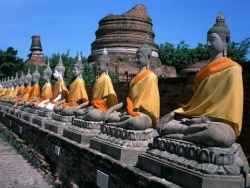Esoteric teachings
Esoteric Buddhism
密教 ( Jpn mikkyo )
Also, esoteric teachings. Those Buddhist teachings that are conveyed secretly or implicitly and are held to be beyond the understanding of ordinary persons. They are defined in contrast to the exoteric teachings, or those teachings that are explicitly revealed and accessible to all. According to the True Word ( Jpn Shingon) school, the esoteric teachings are those teachings that Mahavairochana Buddha preached secretly to Vajrasattva, who compiled them and sealed them in an iron tower in southern India. The school holds that they contain the enlightenment of Mahavairochana Buddha, which is said to be beyond ordinary understanding.The line of transmission of Esoteric Buddhism is held to be from Vajrasattva to Nagarjuna, and then down through Nagabodhi, Chin-kang-chih (Skt Vajrabodhi), Pu-k'ung (Amoghavajra), Hui-kuo, and finally to Kobo, the founder of the True Word school in Japan. The school also lists eight patriarchs who upheld Esoteric Buddhism: Nagar-juna and Nagabodhi who spread it in India; Chin-kang-chih, Pu-k'ung, and Shanwuwei (Shubhakarasimha) who introduced and established it in China; I-hsing and Hui-kuo who propagated it in China; and Kobowho brought it to Japan.
Esoteric Buddhism in India was a form of Tantrism that incorporates indigenous magical and ritualistic elements such as symbolic gestures (mudras) and spells (mantras), as well as diagrams (mandalas) and the worship of numerous deities.Shanwuwei, Chin-kang-chih, and Pu-k'ung introduced Esoteric Buddhism to China. Kobo(774-835), who went to China and studied under Hui-kuo, a disciple of Pu-k'ung, brought these teachings to Japan. He systematized them as the Japanese True Word school. According to this school, the esoteric teachings are the three mysteries—the mind, mouth, and body—of Mahavairochana Buddha. Mahavairochana is believed to be omnipresent, constantly expounding the Law for his own enjoyment.
Through the fusion of the common mortal's three categories of action—mind, mouth, and body—with Mahavairochana's three mysteries, people can understand the Buddha's teachings. Kobotaught that, by forming mudras with one's hands, chanting mantras with one's mouth, and concentrating one's mind on mandalas as objects of devotion, one could become identical with Mahavairochana Buddha.
That is, Kobosaid that the practice of the three mysteries enabled one to attain Buddhahood in one's present form. Thus his teachings are referred to as esoteric.Shakyamuni Buddha, on the other hand, who appeared in this world as a human being, expounded his teachings in accordance with the people's capacity. The True Word school claims that, because these teachings were expounded explicitly within the reach of the people's understanding, they are to be called exoteric and are inferior to the teachings of the transcendent Mahavairochana Buddha. Esoteric teachings were also endorsed by the Tendai school.
Tendai Esotericism was developed by Jikaku, the third chief priest of the Tendai school, Chisho, the fifth chief priest, and others. Unlike Kobo's True Word school, Tendai Esotericism holds that Shakyamuni and Mahavairochana are two aspects of the same Buddha. Tendai Esotericism views the three vehicles as exoteric teachings, and the one vehicle as the esoteric teaching. It classifies such sutras as the Lotus and the Flower Garland as onevehicle, and therefore esoteric, sutras. Because they do not mention mudras and mantras, which constitute esoteric practice, however, those sutras are called esoteric teachings in theory, while the Mahavairochana and Diamond Crown sutras are called esoteric teachings in both theory and practice. Tendai Esotericism claims that, while the Lotus and Mahavairochana sutras are equal in terms of principle, the Mahavairochana Sutra is superior in terms of practice.
